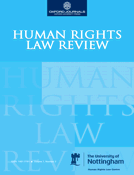 The current issue of the European Human Rights Law Review ([2009] 3 EHRLR | table of contents (pdf) | hat tip ECHR blog) contains a wonderful piece by my colleague Dr Ewa Komorek entitled “Is Media Pluralism a Human Right? The European Court of Human Rights, the Council of Europe and the Issue of Media Pluralism” [2009] 3 EHRLR 395.
The current issue of the European Human Rights Law Review ([2009] 3 EHRLR | table of contents (pdf) | hat tip ECHR blog) contains a wonderful piece by my colleague Dr Ewa Komorek entitled “Is Media Pluralism a Human Right? The European Court of Human Rights, the Council of Europe and the Issue of Media Pluralism” [2009] 3 EHRLR 395.
Here is the abstract (with added links):
The need for pluralist media stopped being purely a national concern a long time ago and thus it has for decades been subject to scrutiny by the Council of Europe and the European Court of Human Rights. Media pluralism has always come to their agenda as a prerequisite for freedom of expression guarded by Article 10 of the European Convention of Human Rights. It is important to distinguish the two ‘faces’ of media pluralism: internal (which may also be called content pluralism or diversity) and external (or structural). This article focuses on television broadcasting and argues that while the Court of Human Rights has essentially been successful in safeguarding internal pluralism, the protection of structural pluralism proved more difficult to achieve by means of the Court’s case law. This prompted the Council of Europe to step in and attempt to fill the gap with regulatory proposals. The conclusion is that although there is still a need for a binding ex ante action at the European level aimed at safeguarding pluralism in this ever concentrating sector, the efforts of the Council of Europe and the judgments of the European Court of Human Rights are vital for awareness raising and stimulating debate.
In Ewa’s view, therefore, media pluralism should be given a far stronger voice in European debates than it currently enjoys, and one way to achieve this would be to strength its status as a right not only in the Council of Europe but also in the EU. For example, Article 11(2) of the EU Charter of Fundamental Rights provides that “the freedom and pluralism of the media shall be respected”, and Ewa’s compelling analysis of the cognate Article 10 can go a long way towards giving full effect to this provision. But this is not the only interesting piece in the journal. Indeed, this issue is a veritable Aladdin’s Cave of fascinating articles:
Gavin Millar writes on “Whither the Spirit of Lingens?” [2009] 3 EHRLR 277, the leading European Court of Human Rights (ECtHR) case on the compatibility of defamation law with the right to freedom of expression in Article 10 of the European Convention on Human Rights (ECHR), an ongoing theme on this blog.
Robert Balin, Laura Handman and Erin Reid write on “Libel Tourism and the Duke’s Manservant—an American Perspective” [2009] 3 EHRLR 303, combining two topics which have featured here in the past.
Eduardo Andrés Bertoni writes on “The Inter-American Court of Human Rights and the European Court of Human Rights: A Dialogue on Freedom of Expression Standards” [2009] 3 EHRLR 332, an extremely informative piece on how the ECHR standards are being received elsewhere.
In the light of the current debate on the blasphemy provisions of the Defamation Act, 2009, Sejal Parmar‘s contribution on “The Challenge of ‘Defamation of Religions’ to Freedom of Expression and the International Human Rights System” [2009] 3 EHRLR 353 could not be more timely.
Stefan Sottiaux writes on “Leroy v France: Apology of Terrorism and the Malaise of the European Court of Human Rights’ Free Speech Jurisprudence” [2009] 3 EHRLR 415. Leroy v France 36109/03 (2 October 2008) concerned a cartoon published on 13 September 2001 concerning the September 11 attacks and (in a parody of a famous advertising slogan) captioned “We have all dreamt of it… Hamas did it”. The cartoonist was convicted for complicity in condoning terrorism and fined 1,500 euro. Having regard to the modest nature of the fine and to the context in which the cartoon had been published, the Court held that there not been a violation of Article 10 of the Convention. Is there a lesson here for Cowengate?
And there is a short note ([2009] 3 EHRLR 440) on Women on Waves v Portugal 31276/05 (03 February 2009) which has already been discussed on this blog.
All in all, then, a bumper issue of an excellent Law Review.
I have three principal public policy concerns at present: Lisbon Treaty, NAMA and media law.
Only on NAMA is there any true pluralism, external or internal. It is fairly difficult for the unsuspecting reader to avoid being bulldozed into submission by pro-Lisbon propaganda. On the rights of others as against the owners and employees of the media, it is almost impossible to find any advocacy.